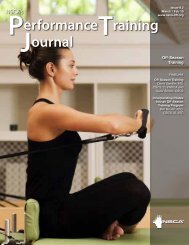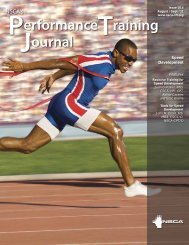PTJ Sep Oct 2010.pdf
PTJ Sep Oct 2010.pdf
PTJ Sep Oct 2010.pdf
You also want an ePaper? Increase the reach of your titles
YUMPU automatically turns print PDFs into web optimized ePapers that Google loves.
ounce of<br />
prevention<br />
Jason Brumitt, MSPT, SCS, ATC/R, CSCS,*D<br />
about the<br />
AUTHOR<br />
Jason Brumitt is an<br />
assistant professor<br />
of physical therapy<br />
at Pacific University<br />
(Oregon). He is<br />
currently a doctoral<br />
candidate with Rocky<br />
Mountain University<br />
of Health Professions.<br />
He can be reached via<br />
email at brum4084@<br />
pacificu.edu.<br />
Develop Power and Core<br />
Strength with Kettlebell<br />
Exercises<br />
To be successful in a sport, an athlete must possess the<br />
ability to generate explosive power (2). But what is power<br />
Basically, it is the ability to perform a lift in as little time as<br />
possible. How is power different from strength An individual<br />
may be able to demonstrate that he or she is very<br />
strong (based on the amount of weight they lift); however,<br />
when they perform a lift, they do it slowly. To develop<br />
power, an athlete must perform exercises in a short period<br />
of time. The traditional power/weightlifting lifts (e.g.,<br />
cleans, snatch, jerk) help facilitate an athlete’s ability to<br />
generate force quickly (2, 4).<br />
Figure 1. 20lbs Kettlebell<br />
The Swings<br />
What if an athlete is unable to perform these exercises<br />
with the traditional barbell and plate equipment Not all<br />
athletes are of the elite collegiate and professional ranks.<br />
An athlete may be a 34-year old woman who is returning<br />
to running eight weeks after delivering her first child. Or<br />
an athlete may be a 75-year old male who is swimming at<br />
the master’s level. Since athletes come in all shapes and<br />
sizes, their training programs should account for their fitness<br />
level and be tailored to meet their individual goals.<br />
The use of kettlebells in one’s training program will help to<br />
enhance core strength and facilitate power development<br />
in non-elite athletes.<br />
If you are not familiar with a kettlebell, it is a cast-iron<br />
weight shaped like a ball with a handle (Figure 1). Kettlebells<br />
range in size from 5lbs to 50lbs, or greater. Although<br />
considered a relatively new piece of equipment, the use<br />
of kettlebells dates back to Russia in the early 1700s (1,<br />
3). Recently, kettlebell training has emerged as a popular<br />
piece of training equipment (3). The unique shape of the<br />
kettlebell allows one to perform traditional exercises to<br />
enhance core strength (Table 1) as well as the swings to<br />
improve functional power (Table 2).<br />
The shape of the kettlebell allows for the ability to perform<br />
swinging motions. By grasping the kettlebell handle<br />
with one or both hands, an individual is able to swing<br />
the kettlebell through a large arc of motion. Performing<br />
a one-handed (Figure 4) or two-handed kettlebell swings<br />
(Figure 5 and 6) activates muscles throughout the body.<br />
Conclusion<br />
These simple exercises (and basic modifications) can be<br />
used to increase core strength and develop functional<br />
power. Not all individuals are alike and as such their training<br />
programs should be tailored to their skills and abilities.<br />
The use of kettlebells offers a safe alternative to the traditional<br />
Olympic weightlifting lifts if performed properly. •<br />
References<br />
1. Farrar RE, Mayhew JL, Koch AJ. Oxygen cost of<br />
kettlebell swings. J Strength Con Res. 2010;24(4):1034 –<br />
1036.<br />
2. Sandler D. Sports Power. Champaign, IL: Human<br />
Kinetics; 2005.<br />
3. Tsatsouline P. Enter the Kettlebell! St. Paul, MN: Dragon<br />
Door Publications, Inc., 2006.<br />
4. Werner G. Strength and conditioning techniques in the<br />
rehabilitation of sports injury. Clin Sports Med. 2010;<br />
29(1):177 – 191.<br />
nsca’s performance training journal • www.nsca-lift.org • volume 9 issue 5<br />
19





